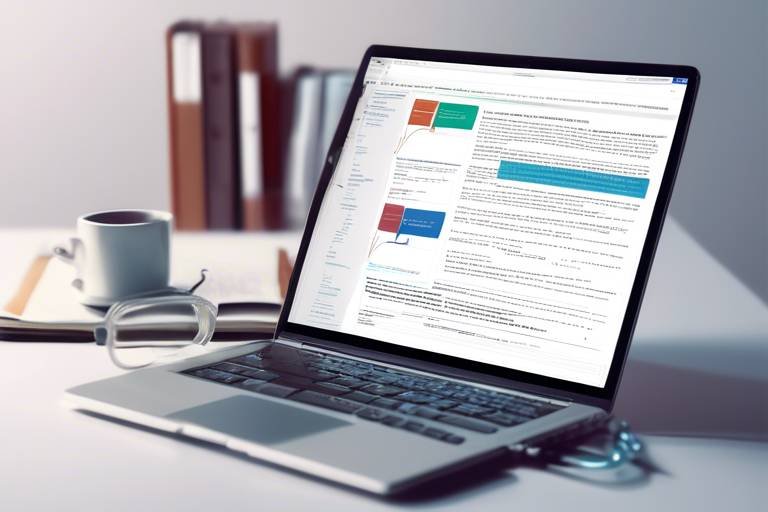The Role of Research Questionnaires in Surveys
Research questionnaires play a pivotal role in the realm of surveys, acting as the backbone for data collection and analysis. They are not merely a collection of questions; they are carefully crafted tools that guide researchers in gathering valuable insights. Imagine embarking on a journey without a map – that's what conducting research without a well-designed questionnaire feels like. These instruments help researchers navigate through the complexities of human behavior, opinions, and experiences, allowing them to uncover trends and patterns that might otherwise remain hidden.
At their core, research questionnaires are structured formats that enable researchers to collect both quantitative and qualitative data. This dual capability is crucial, as it provides a comprehensive view of the subject matter being studied. Quantitative data offers hard numbers that can be analyzed statistically, while qualitative data enriches the findings with personal stories and detailed insights. Together, they create a holistic picture that enhances the validity and reliability of the research outcomes.
Moreover, the design and implementation of research questionnaires significantly impact the quality of the data collected. A thoughtfully designed questionnaire can engage respondents, prompting them to provide thoughtful and honest answers. Conversely, a poorly structured questionnaire can lead to confusion, frustration, and ultimately, unreliable data. This highlights the importance of understanding the nuances of questionnaire design, including question types, wording, and the overall flow of the survey.
As we delve deeper into the world of research questionnaires, we will explore various types, their advantages and challenges, and how effective design and administration can enhance the research experience. By understanding these elements, researchers can harness the full potential of questionnaires, transforming them from simple survey tools into powerful instruments of discovery.
- What is a research questionnaire?
A research questionnaire is a structured tool used to gather information from respondents, facilitating the collection of both quantitative and qualitative data.
- Why are research questionnaires important?
They help researchers collect valuable insights, identify trends, and analyze behaviors, which are essential for informed decision-making.
- What are the different types of questionnaires?
There are open-ended, closed-ended, and hybrid questionnaires, each serving different research objectives.
- How can I design an effective questionnaire?
Focus on clarity, simplicity, and logical flow to ensure that respondents understand and engage with the questions.

Understanding Research Questionnaires
Research questionnaires are essential tools in the field of data collection, serving as structured instruments designed to gather valuable information from respondents. Think of them as the bridge between researchers and the insights they seek; they facilitate the flow of information that is crucial for various studies, ranging from market research to academic inquiries. By employing these questionnaires, researchers can collect both quantitative and qualitative data, which are vital for understanding trends, behaviors, and opinions.
At their core, research questionnaires are about asking the right questions in the right way. They can take many forms, from simple multiple-choice questions to complex open-ended prompts that invite detailed responses. The design of a questionnaire can significantly impact the quality of data collected, making it imperative for researchers to pay close attention to how they formulate their questions. Moreover, the effectiveness of a questionnaire isn't just about the questions themselves; it also involves how these questions are presented and the context in which they are asked.
One of the primary goals of a research questionnaire is to ensure that the data collected is both reliable and valid. This means that the questions should accurately measure what they are intended to measure, and the responses should be consistent across different respondents. To achieve this, researchers often pilot their questionnaires, testing them on a small group before full-scale deployment. This practice helps identify any ambiguities or biases in the questions, allowing for refinements that enhance the overall quality of the survey.
In addition to the design and formulation of questions, the administration of questionnaires plays a crucial role in data collection. Researchers can choose from various methods, such as online surveys, telephone interviews, or face-to-face interactions. Each method has its own set of advantages and challenges, influencing the response rates and the depth of the data collected. For instance, online surveys can reach a broader audience quickly, while in-person surveys may yield richer, more nuanced data due to the opportunity for immediate clarification and engagement.
Ultimately, understanding research questionnaires is about recognizing their significance in the broader context of survey methodologies. They are not merely a collection of questions; they are strategic instruments that, when designed and implemented effectively, can unlock a wealth of information. As researchers continue to explore new ways to enhance data collection, the importance of well-constructed questionnaires will only grow, paving the way for more insightful and impactful research outcomes.
- What is the purpose of a research questionnaire?
The primary purpose is to gather information from respondents to analyze trends, behaviors, and opinions. - What are the different types of questionnaires?
Questionnaires can be open-ended, closed-ended, or hybrid, each serving different research objectives. - How can I ensure my questionnaire is effective?
Focus on clarity, logical flow, and relevance of questions. Pilot testing is also recommended. - What are the challenges in using questionnaires?
Challenges include response bias, low response rates, and potential misinterpretation of questions.

Types of Questionnaires
When it comes to collecting data through surveys, understanding the different is essential. Each type serves a unique purpose and can significantly influence the quality of the data collected. Let's dive into the main categories: open-ended, closed-ended, and hybrid questionnaires.
Open-ended questionnaires are designed to allow respondents to express their thoughts freely. These questionnaires do not limit answers to predefined options, which can lead to rich qualitative insights. Imagine asking someone about their favorite vacation. Instead of choosing from a list of destinations, they can share their personal experiences, feelings, and anecdotes. This type of feedback can be incredibly valuable for researchers who seek a deeper understanding of their subjects. However, the challenge lies in analyzing these responses, as they can be time-consuming and subjective.
On the other hand, we have closed-ended questionnaires. These are structured with specific options for respondents to choose from, making data collection straightforward. Think of it as a multiple-choice exam where you pick one answer from a list. This format is particularly useful for quantitative research, as it allows for easy statistical analysis. However, while closed-ended questions simplify data processing, they may not capture the full depth of respondents' opinions. For instance, if you ask about vacation preferences but only offer a limited selection of destinations, you might miss out on unique insights that could emerge from an open-ended format.
Lastly, there are hybrid questionnaires, which combine elements of both open and closed-ended formats. This approach allows researchers to gather diverse data types, providing a balanced view of respondents' opinions. In a hybrid questionnaire, you might start with a closed-ended question to gauge general preferences, followed by an open-ended question that invites further elaboration. For example, you could ask, "What is your favorite vacation spot?" (closed-ended) and then follow up with, "Why do you love it?" (open-ended). This combination can lead to a more comprehensive understanding of the topic at hand.
In summary, the type of questionnaire chosen can greatly impact the data collection process. While open-ended questionnaires offer depth and nuance, closed-ended ones provide clarity and ease of analysis. Hybrid questionnaires, meanwhile, strike a balance, allowing for both quantitative and qualitative insights. Understanding these types will help researchers design effective surveys that meet their specific objectives.

Open-Ended Questionnaires
Open-ended questionnaires are a fascinating tool in the world of research, allowing respondents to express their thoughts and feelings in their own words. Unlike closed-ended questionnaires, which restrict answers to predefined options, open-ended questions invite a more personal and nuanced response. This format encourages creativity and depth, enabling researchers to capture the richness of human experience. Imagine asking someone, "What do you think about climate change?" instead of offering a simple yes or no. The responses can reveal a myriad of perspectives, insights, and emotions that numbers alone could never convey.
However, while the benefits of open-ended questionnaires are substantial, they come with their own set of challenges. Analyzing the responses can be quite time-consuming and subjective. Researchers often need to engage in careful coding and categorization to extract meaningful insights from the diverse answers provided. This process can feel like searching for a needle in a haystack, especially when the responses vary widely in length and detail. To tackle this, researchers might employ qualitative analysis techniques, such as thematic analysis, to identify common themes and patterns across responses.
Another important aspect to consider is the context in which open-ended questions are posed. The way a question is framed can significantly influence the type of responses received. For instance, asking "What are your thoughts on the effectiveness of renewable energy sources?" may yield different insights than "How do you feel about solar power in your community?" The former is broader, while the latter is more specific, guiding respondents to reflect on their personal experiences.
In summary, open-ended questionnaires are a powerful tool for gathering qualitative data, providing researchers with in-depth insights into respondents' thoughts and feelings. However, the complexities of analyzing such data require careful planning and execution. By understanding both the advantages and challenges of this questionnaire type, researchers can better harness its potential to enrich their studies.
- What are open-ended questionnaires? Open-ended questionnaires are survey tools that allow respondents to answer questions in their own words, providing rich qualitative data.
- What are the advantages of using open-ended questions? They facilitate deeper understanding, capture nuanced responses, and encourage creativity among respondents.
- What challenges do researchers face with open-ended questions? Analyzing open-ended responses can be time-consuming and subjective, requiring careful interpretation and coding.
- How can the design of open-ended questions impact responses? The way questions are framed can influence the type and depth of responses received, making clarity and context crucial.

Advantages of Open-Ended Questions
Open-ended questions are a treasure trove for researchers, offering a wealth of qualitative insights that closed-ended questions simply cannot match. When respondents are given the freedom to express their thoughts in their own words, the richness of their responses can reveal underlying motivations, feelings, and perspectives. This depth of understanding is crucial, especially in fields like psychology, sociology, and market research, where context matters immensely.
One of the standout advantages of open-ended questions is their ability to uncover unexpected insights. Imagine you're conducting a survey about customer satisfaction with a product. While a closed-ended question might limit responses to predefined options like "satisfied," "neutral," or "dissatisfied," an open-ended question like "What do you think about our product?" invites customers to share their unique experiences. This can lead to discovering issues or benefits that you hadn’t even considered, allowing for a more nuanced view of customer sentiment.
Furthermore, open-ended questions encourage creativity and personal expression. Respondents can articulate their thoughts in ways that resonate with their individual experiences, leading to responses that are not only informative but also engaging. This can create a more dynamic interaction between the researcher and the respondent, fostering a sense of involvement and ownership in the research process.
However, it’s important to acknowledge that analyzing these responses can be a double-edged sword. While they provide rich data, the subjective nature of open-ended answers means that researchers must invest considerable time and effort into coding and interpreting the responses. This analysis often requires identifying themes and patterns, which can be both challenging and rewarding, as it leads to a deeper understanding of the subject matter.
In summary, the advantages of open-ended questions include:
- Rich Qualitative Insights: They provide detailed responses that capture the complexity of human thoughts and feelings.
- Uncovering Unexpected Insights: They can reveal issues or benefits that researchers may not have anticipated.
- Encouraging Creativity: Respondents have the freedom to express their views in their own words, enhancing engagement.
By leveraging the strengths of open-ended questions, researchers can enrich their data collection efforts, leading to findings that are not only more comprehensive but also more reflective of the diverse perspectives of respondents.
- What is an open-ended question? An open-ended question is one that allows respondents to answer in their own words, providing detailed and qualitative insights.
- What are the main advantages of using open-ended questions in surveys? They offer rich qualitative data, uncover unexpected insights, and encourage creativity and personal expression from respondents.
- How do you analyze open-ended responses? Analyzing open-ended responses typically involves coding the answers to identify themes and patterns, which can be time-consuming but yields valuable insights.

Challenges of Open-Ended Questions
Open-ended questions are often hailed as the golden ticket to uncovering in-depth insights from respondents, but they come with their own set of challenges that can make the analysis process a bit of a rollercoaster ride. One of the primary hurdles is the sheer volume of data generated. Unlike closed-ended questions, where responses are neatly categorized, open-ended questions can produce a vast array of answers, each unique and often complex. This diversity can be overwhelming, as researchers must sift through potentially hundreds or thousands of individual responses to find patterns or themes.
Moreover, the analysis of open-ended responses requires a level of subjective interpretation that can introduce bias. Researchers might unconsciously project their own perspectives onto the data, leading to skewed interpretations. This subjectivity can be particularly problematic when the goal is to maintain objectivity in research. For instance, if a respondent provides a nuanced opinion on a topic, a researcher might interpret it through a personal lens rather than capturing the essence of the respondent's intent. This phenomenon can compromise the reliability of the findings.
Additionally, the time and resources required for analyzing open-ended questions can be significant. Unlike closed-ended questions that can be quantified easily, open-ended responses often necessitate careful coding and thematic analysis, which can be labor-intensive. Researchers may need to employ qualitative data analysis software or even manual coding methods to categorize responses effectively. This process not only takes time but also demands a level of expertise in qualitative research methods, which not all researchers possess.
Another challenge is ensuring that the questions asked are truly open-ended. Sometimes, researchers may inadvertently phrase questions in a way that leads respondents toward a particular answer, thus limiting the richness of the data collected. For example, asking, "What do you think about our product's features?" might elicit a more focused response compared to a broader question like, "What are your thoughts on our product?" This subtle difference can significantly impact the quality and depth of the insights gathered.
In summary, while open-ended questions offer a treasure trove of qualitative data, they come with challenges that require careful consideration and planning. Researchers must be prepared to tackle the complexities of data analysis, maintain objectivity, and design questions that truly encourage expansive responses. By acknowledging these challenges, researchers can better navigate the intricacies of open-ended questions and leverage their strengths to enhance their studies.
- What are open-ended questions? Open-ended questions are those that allow respondents to answer in their own words, providing detailed and nuanced responses.
- Why are open-ended questions important in research? They are important because they provide deeper insights and a richer understanding of respondents' thoughts and feelings.
- What are the main challenges of using open-ended questions? The main challenges include data volume, subjective interpretation, time-consuming analysis, and the risk of leading questions.
- How can researchers mitigate the challenges of open-ended questions? Researchers can mitigate these challenges by using qualitative analysis tools, ensuring clarity in question design, and being aware of their biases during interpretation.

Closed-Ended Questionnaires
Closed-ended questionnaires are an essential tool in survey research, offering a structured way for respondents to provide their answers. Unlike open-ended questionnaires, where participants can elaborate freely, closed-ended questionnaires limit responses to predefined options. This structure simplifies the data collection process and facilitates easier analysis, making them particularly valuable in quantitative research. By providing specific choices, researchers can gather clear, concise data that can be quickly interpreted and analyzed.
One of the primary advantages of closed-ended questionnaires is their ability to streamline the data analysis process. Since respondents select from given options, researchers can easily quantify responses and apply statistical methods to derive meaningful insights. For instance, if a survey seeks to understand customer satisfaction, a question might ask, "How satisfied are you with our service?" with options ranging from "Very Unsatisfied" to "Very Satisfied." This clear framework allows for straightforward aggregation of responses, leading to quick identification of trends and patterns.
However, while closed-ended questionnaires are efficient, they also come with limitations. The fixed nature of the responses can restrict the depth of information gathered. Respondents may feel constrained by the options provided, leading to potential frustration or disengagement. It's crucial for researchers to carefully design the response options to ensure they are comprehensive and reflective of the possible sentiments of the participants. This is where a well-thought-out question design becomes imperative.
To enhance the effectiveness of closed-ended questionnaires, researchers often employ various types of response formats, such as:
- Multiple Choice: Respondents select one or more options from a list.
- Rating Scales: Participants rate their agreement or satisfaction on a scale, such as 1 to 5.
- Yes/No Questions: Simple binary options that provide clear data points.
When designing closed-ended questions, it's essential to consider the target audience and the objectives of the research. Questions should be relevant, clear, and unbiased to elicit authentic responses. For example, instead of asking, "Do you think our service is bad?" which could lead to biased responses, a better-phrased question would be, "How would you rate our service?" This subtle shift encourages more thoughtful engagement from respondents.
In summary, closed-ended questionnaires are a powerful tool in survey methodologies, providing a systematic approach to data collection. While they offer significant advantages in terms of efficiency and ease of analysis, careful consideration must be given to the design of questions and response options. By striking the right balance, researchers can extract valuable insights that drive informed decisions and strategies.
Q1: What are the main advantages of closed-ended questionnaires?
A1: The main advantages include ease of analysis, clarity of responses, and the ability to quantify data quickly, making it easier to identify trends and patterns.
Q2: Can closed-ended questionnaires limit the depth of information?
A2: Yes, they can restrict the richness of responses as participants may feel constrained by the predefined options, potentially missing out on nuanced perspectives.
Q3: How can I ensure my closed-ended questions are effective?
A3: Ensure that questions are clear, relevant, and unbiased. Consider using a variety of response formats to capture a broader range of data while keeping the options comprehensive.
Q4: What types of response formats are commonly used in closed-ended questionnaires?
A4: Common formats include multiple choice, rating scales, and yes/no questions, each serving different research purposes.

Designing Effective Questionnaires
Designing effective questionnaires is a crucial step in the research process, as the quality of the data collected significantly hinges on how well the questions are formulated. A well-designed questionnaire not only enhances the reliability of the data but also ensures that the information gathered is relevant to the research objectives. To achieve this, researchers must focus on several key aspects, including clarity, relevance, and the logical flow of questions. Each of these elements plays a vital role in guiding respondents through the survey, ultimately leading to richer data collection.
Clarity is paramount when crafting questions. If respondents find a question confusing or ambiguous, the data collected can become unreliable. For instance, consider a question like, "How often do you exercise?" without any context. This question could lead to varied interpretations—some may think it refers to formal workouts, while others might include casual activities. Therefore, it's essential to use straightforward language and be specific about what you are asking. Questions should be structured in a way that leaves little room for misinterpretation.
Relevance is another critical factor. Each question should serve a purpose and relate directly to the research objectives. Including irrelevant questions can frustrate respondents and lead to disengagement. To maintain relevance, researchers can use a filtering technique where questions are tailored based on previous responses. For example, if a respondent indicates they do not own a car, subsequent questions about vehicle maintenance should be skipped. This not only keeps the questionnaire concise but also respects the respondent's time.
The logical flow of questions is equally important. A well-structured questionnaire should guide respondents through a natural progression of topics. Starting with general questions and gradually moving to more specific ones can help ease respondents into the survey. This approach enhances engagement and encourages respondents to provide thoughtful answers. For instance, beginning with demographic questions can set the stage for more detailed inquiries about attitudes or behaviors.
Moreover, incorporating a mix of question types can keep respondents interested. While closed-ended questions are efficient for quantitative analysis, open-ended questions can provide deeper insights. For example, after a series of closed-ended questions about product satisfaction, an open-ended question like, "What improvements would you suggest for our product?" allows respondents to express their thoughts freely, providing valuable qualitative data.
In conclusion, designing effective questionnaires is an art that requires careful consideration of clarity, relevance, and logical flow. By focusing on these elements, researchers can create tools that not only gather reliable data but also engage respondents effectively. As we move forward in the digital age, the importance of well-designed questionnaires will only grow, making it essential for researchers to hone their skills in this area.
- What is the importance of clarity in questionnaire design?
Clarity ensures that respondents understand the questions, which leads to more accurate and reliable data.
- How can I ensure my questions are relevant?
Each question should directly relate to the research objectives, and you can use filtering techniques to skip irrelevant questions based on previous answers.
- What is the best way to structure my questionnaire?
Start with general questions and gradually move to specific ones, maintaining a logical flow that engages respondents.

Clarity and Simplicity
When it comes to designing research questionnaires, are your best friends. Imagine trying to navigate through a maze with unclear directions; that’s what it feels like for respondents faced with complicated questions. If your questions are muddled or overly complex, you risk losing valuable insights because respondents may misinterpret what you’re asking. Therefore, it’s crucial to use straightforward language that anyone can understand. This not only helps in gathering accurate data but also enhances the overall experience for the respondent.
To achieve this, consider the following key points:
- Avoid Jargon: Unless your audience is familiar with specific terminology, steer clear of jargon or technical terms that could confuse them.
- Be Direct: Ask questions that get straight to the point. For instance, instead of saying, “How do you feel about the implementation of the new policy?” you could simply ask, “Do you like the new policy?”
- Limit Question Length: Long-winded questions can lead to confusion. Aim to keep questions concise while still providing enough context.
Moreover, using a logical structure helps respondents follow the flow of the questionnaire. Think of it like telling a story—each question should lead naturally to the next, creating a smooth narrative that keeps the respondent engaged. A well-structured questionnaire not only enhances clarity but also encourages respondents to provide thoughtful answers.
In summary, prioritizing clarity and simplicity in your questionnaire design can significantly improve the quality of your data collection. By ensuring that your questions are easy to understand and logically organized, you pave the way for more reliable and insightful responses, ultimately leading to a more successful research outcome.
- What is the importance of clarity in questionnaires? Clarity in questionnaires ensures that respondents understand the questions, leading to more accurate and reliable data collection.
- How can I simplify my questionnaire? You can simplify your questionnaire by using straightforward language, avoiding jargon, and keeping questions concise.
- What are the benefits of a well-structured questionnaire? A well-structured questionnaire enhances engagement, improves data quality, and allows for easier analysis of responses.

Logical Flow of Questions
When designing a questionnaire, the is essential for guiding respondents through the survey in a way that feels natural and intuitive. Imagine walking through a well-organized museum; each exhibit leads you to the next, allowing you to build your understanding progressively. Similarly, a well-structured questionnaire helps respondents navigate topics seamlessly, reducing confusion and enhancing engagement.
To achieve a logical flow, it's important to start with broad questions and gradually narrow down to more specific ones. This approach not only warms up the respondent but also sets the stage for deeper insights. For instance, if you're conducting a survey about consumer habits, you might begin with general questions about shopping frequency before diving into specific preferences for products or brands.
Another key aspect of maintaining logical flow is the thematic grouping of questions. Grouping related questions together helps respondents stay focused and makes the survey feel cohesive. For example, if your questionnaire covers various aspects of health and wellness, you could cluster questions about nutrition, exercise, and mental health into separate sections. This organization allows respondents to think about each theme without jumping back and forth between unrelated topics.
Additionally, consider the order of questions. Starting with less sensitive or easier questions can help ease respondents into the survey, building their confidence to tackle more complex or personal inquiries later on. For instance, if your questionnaire includes questions about financial habits, you might want to begin with general questions about spending before moving on to more specific inquiries about income or savings.
Lastly, it’s crucial to include transition statements or questions that link different sections. These prompts can serve as a bridge, helping respondents understand why they're moving from one topic to another. For example, after completing a section on shopping habits, you might introduce the next section on brand loyalty with a statement like, “Now that we’ve discussed your shopping habits, let’s explore how brand loyalty influences your purchasing decisions.”
In summary, achieving a logical flow in your questionnaire design is about creating a journey for your respondents. By carefully considering the order, grouping, and transitions of your questions, you can enhance the overall quality of the data collected and ensure a more engaging experience for those participating in your survey.
- What is the importance of logical flow in questionnaires?
The logical flow helps respondents navigate the survey easily, reducing confusion and improving the quality of responses.
- How can I ensure my questions are grouped effectively?
Group questions by theme and ensure that they progress from general to specific to maintain a natural flow.
- What should I avoid in questionnaire design?
Avoid jumping between unrelated topics and using ambiguous language that can confuse respondents.
- How does the order of questions affect responses?
Starting with easier questions can build confidence and lead to more thoughtful answers on sensitive topics later in the survey.

Administering Questionnaires
Administering questionnaires is a critical step in the research process that can significantly influence the quality of data collected. The method chosen for administering the questionnaire can affect response rates, data integrity, and the overall success of the research. Researchers have several options at their disposal, including online surveys, telephone interviews, and in-person questionnaires. Each method has its own set of advantages and challenges, which can impact how respondents engage with the questions posed to them.
Online surveys have surged in popularity, primarily due to their convenience and cost-effectiveness. With just a few clicks, researchers can reach a broad audience, which can be particularly advantageous for studies requiring diverse demographic representation. Furthermore, online platforms often provide tools for real-time data collection and analysis, allowing researchers to monitor responses as they come in. However, it's essential to consider that while online surveys are efficient, they may also lead to lower engagement from certain populations, particularly those who are less tech-savvy or lack internet access.
On the other hand, in-person surveys can yield richer data and higher response rates. When researchers interact directly with respondents, they have the opportunity to clarify questions, address any misunderstandings, and build rapport, which can lead to more thoughtful and comprehensive responses. This method is particularly useful in qualitative research, where the nuances of human interaction can provide deeper insights into respondents' thoughts and feelings. However, in-person surveys can be resource-intensive, requiring more time and effort to administer effectively.
Regardless of the method chosen, researchers must ensure that the questionnaire is administered in a way that maximizes response rates and minimizes bias. This may involve providing clear instructions, ensuring the anonymity of responses, and following up with participants to encourage completion. Additionally, researchers should be aware of the potential for response bias, which can occur when respondents feel pressured to provide socially acceptable answers rather than their true opinions. By creating a comfortable environment for respondents and emphasizing the importance of honest feedback, researchers can help mitigate this issue.
In conclusion, the method of administering questionnaires plays a pivotal role in the overall effectiveness of survey research. Each approach has its unique benefits and drawbacks, and researchers must carefully consider their objectives, target audience, and available resources when deciding how to administer their questionnaires. By strategically choosing the right method, researchers can enhance data quality and ensure that their findings are both valid and reliable.
- What is the best method for administering questionnaires? The best method depends on your target audience and research goals. Online surveys are great for reaching a wide audience, while in-person surveys can provide richer data.
- How can I improve response rates for my questionnaire? To improve response rates, ensure clarity in your questions, provide incentives, and follow up with participants to remind them to complete the survey.
- What are the common challenges in administering questionnaires? Common challenges include low response rates, response bias, and logistical issues related to the chosen method of administration.

Online Surveys
Online surveys have rapidly become a favored method for data collection in research, and it's easy to see why. Imagine being able to reach thousands of respondents from the comfort of your own home, all while gathering valuable insights that can shape future decisions. The convenience and accessibility of online surveys allow researchers to connect with a diverse audience, transcending geographical boundaries. This method not only saves time and resources but also offers an efficient way to collect large amounts of data quickly.
One of the standout features of online surveys is their cost-effectiveness. Traditional survey methods, such as in-person interviews or mailed questionnaires, often involve significant expenses related to printing, postage, and travel. In contrast, online surveys eliminate these costs, allowing researchers to allocate their budgets more effectively. Additionally, platforms for conducting online surveys often provide built-in tools for data analysis, further streamlining the research process.
Moreover, online surveys offer a level of flexibility that is hard to match. Researchers can easily modify questions, change the order, or even add new sections to the survey based on ongoing feedback. This adaptability ensures that the survey remains relevant and can evolve with the research objectives. Furthermore, online surveys can incorporate multimedia elements, such as images and videos, which can enhance the respondent's experience and provide richer data.
However, while online surveys present numerous advantages, they also come with their own set of challenges. For instance, not all demographic groups have equal access to the internet, which can lead to potential bias in the data collected. To mitigate this issue, researchers should consider employing a mixed-method approach, combining online surveys with other data collection methods to ensure a more representative sample. Moreover, it's crucial to design the survey thoughtfully, paying attention to question clarity and flow to minimize respondent fatigue and maximize completion rates.
In conclusion, online surveys are a powerful tool in the research arsenal, offering a blend of efficiency, cost-effectiveness, and flexibility. As technology continues to evolve, the capabilities of online surveys will expand, making them an even more integral part of data collection strategies. By understanding both their strengths and limitations, researchers can harness the full potential of online surveys to gather meaningful insights that drive informed decision-making.
- What are online surveys? Online surveys are digital questionnaires that allow researchers to collect data from respondents via the internet.
- What are the benefits of using online surveys? They are cost-effective, accessible, flexible, and can reach a wide audience quickly.
- Are there any drawbacks to online surveys? Yes, potential drawbacks include sample bias due to unequal internet access and the need for careful question design to avoid misinterpretation.
- How can I increase response rates for online surveys? To enhance response rates, consider using engaging designs, keeping surveys concise, and offering incentives for completion.

In-Person Surveys
In-person surveys are a powerful method for collecting data, often yielding richer and more nuanced responses than their online counterparts. When researchers engage directly with respondents, they can foster a sense of trust and openness that encourages participants to share their thoughts more freely. Imagine sitting down with someone over coffee, discussing their opinions and experiences—this personal touch can lead to insights that are simply unattainable through a screen.
One of the most significant advantages of in-person surveys is the ability to clarify questions on the spot. If a respondent is unsure about what a particular question means, the researcher can provide immediate clarification, ensuring that the answers collected are accurate and reflective of the respondent's true feelings. This dynamic interaction can also help to probe deeper into responses, allowing for follow-up questions that can uncover layers of meaning behind the initial answers.
Despite their advantages, in-person surveys do come with their own set of challenges. For instance, they typically require more resources in terms of time and money. Researchers must consider logistics such as travel, location, and the need for trained interviewers. However, the investment can be worth it when considering the quality of data obtained. To illustrate this point, here's a quick comparison of in-person surveys versus online surveys:
| Aspect | In-Person Surveys | Online Surveys |
|---|---|---|
| Response Quality | High; allows for nuanced responses | Varies; can be superficial |
| Cost | Higher; travel and personnel expenses | Lower; minimal overhead |
| Engagement | High; personal interaction | Variable; depends on respondent motivation |
| Response Rate | Generally higher | Can be lower, especially if lengthy |
In conclusion, while in-person surveys may require a greater investment of resources, the potential for deeper understanding and richer data makes them a valuable tool in the researcher’s arsenal. By combining the human element with structured inquiry, researchers can unlock insights that make their findings not only more reliable but also more relevant to real-world issues.
- What are the main benefits of in-person surveys? In-person surveys allow for immediate clarification of questions, higher engagement, and richer, more nuanced responses.
- Are in-person surveys more expensive than online surveys? Yes, in-person surveys typically incur higher costs due to travel and personnel expenses.
- How can I improve response rates in in-person surveys? Building rapport with respondents, offering incentives, and ensuring a comfortable environment can enhance response rates.
- What challenges do researchers face with in-person surveys? Challenges include logistical issues, higher costs, and the need for trained personnel to conduct interviews effectively.

Analyzing Questionnaire Data
When it comes to , the process is not merely about crunching numbers or categorizing responses. It's an intricate dance of interpretation, where the aim is to extract meaningful insights that can inform decisions, policies, and strategies. The analysis can be broadly divided into two categories: quantitative analysis and qualitative analysis. Each plays a vital role depending on the type of data collected and the research objectives.
Quantitative analysis is primarily concerned with numerical data gathered from closed-ended questions. It employs various statistical methods to identify trends, averages, and correlations within the data. For instance, researchers might use tools like SPSS or Excel to run descriptive statistics, which summarize the basic features of the data. This could include calculating means, medians, and modes to understand the central tendency of responses. Furthermore, inferential statistics can be employed to make predictions or generalizations about a larger population based on the sample data. This type of analysis is particularly useful when researchers need to make data-driven decisions supported by solid numerical evidence.
On the other hand, qualitative analysis dives into the rich, narrative responses provided in open-ended questions. This form of analysis seeks to uncover themes, patterns, and deeper meanings behind the respondents' answers. Techniques like thematic analysis or content analysis can be utilized to categorize responses into different themes, allowing researchers to understand the context and sentiments of the participants. For example, if a survey question asks, "What do you think about our product?" the responses can be analyzed to identify common themes such as satisfaction, usability, or areas for improvement. By interpreting these qualitative insights, researchers can gain a deeper understanding of consumer attitudes and preferences.
To illustrate the differences between these two analytical approaches, consider the following table:
| Aspect | Quantitative Analysis | Qualitative Analysis |
|---|---|---|
| Data Type | Numerical | Descriptive |
| Focus | Statistical trends and correlations | Themes and patterns in responses |
| Tools | SPSS, Excel, R | Thematic analysis, content analysis |
| Outcome | Generalizable results | In-depth understanding |
Ultimately, the choice between quantitative and qualitative analysis—or a combination of both—depends on the research goals. For instance, a business looking to launch a new product might use quantitative analysis to gauge potential market size and customer demographics, while also employing qualitative analysis to understand consumer sentiment and preferences. This dual approach enriches the understanding of the data and leads to more informed decision-making.
As researchers embark on the journey of analyzing questionnaire data, they must remain mindful of the importance of context. Data without context can lead to misinterpretations, which could skew results and lead to misguided conclusions. Thus, combining both analytical methods not only broadens the scope of findings but also enhances the reliability and validity of the research.
- What is the main purpose of analyzing questionnaire data? The main purpose is to extract meaningful insights that can guide decision-making and inform strategies based on the collected data.
- How can I choose between quantitative and qualitative analysis? The choice depends on your research objectives; use quantitative analysis for numerical trends and qualitative analysis for in-depth understanding of responses.
- What tools can I use for data analysis? Common tools include SPSS, Excel, and R for quantitative analysis, while thematic analysis and content analysis methods are used for qualitative data.

Quantitative Analysis
Quantitative analysis is a pivotal aspect of survey research, primarily focusing on the numerical data collected through closed-ended questions. This method allows researchers to apply statistical techniques to interpret results, identify trends, and draw meaningful conclusions. By converting responses into quantifiable data, researchers can uncover patterns that might not be immediately visible through qualitative analysis alone. For instance, if a survey question asks respondents to rate their satisfaction on a scale from 1 to 5, the results can be easily aggregated to determine the average satisfaction level across a population.
The beauty of quantitative analysis lies in its ability to provide a clear, objective picture of the data. This objectivity is crucial when presenting findings to stakeholders, as it lends credibility to the research. Moreover, quantitative analysis can facilitate comparisons across different demographic groups or time periods, enabling researchers to track changes and make informed decisions based on solid evidence.
To illustrate how quantitative analysis works, consider the following example:
| Rating | Number of Respondents |
|---|---|
| 1 (Very Dissatisfied) | 5 |
| 2 (Dissatisfied) | 10 |
| 3 (Neutral) | 15 |
| 4 (Satisfied) | 20 |
| 5 (Very Satisfied) | 10 |
In this example, researchers can calculate the average satisfaction rating by summing the products of each rating and its corresponding number of respondents, then dividing by the total number of respondents. This kind of analysis not only provides a straightforward summary of the data but also allows for deeper insights when segmented by different demographics, such as age or location.
Moreover, quantitative analysis can also help identify correlations and relationships between different variables. For instance, researchers might explore whether higher satisfaction ratings correlate with specific demographics, like age or income level. This can lead to actionable insights, such as tailoring services to better meet the needs of particular groups.
However, it's important to remember that while quantitative analysis is powerful, it does have its limitations. It often relies on predefined response options, which can restrict respondents' ability to express their true feelings or opinions. Therefore, combining quantitative analysis with qualitative methods can provide a more comprehensive understanding of the research topic, allowing for a richer exploration of the data.
- What is the primary goal of quantitative analysis?
The primary goal is to quantify data and uncover patterns and relationships through statistical methods. - How does quantitative analysis differ from qualitative analysis?
Quantitative analysis focuses on numerical data and statistical techniques, while qualitative analysis explores non-numerical insights and themes. - Can quantitative analysis be used in all types of research?
While it's highly effective in many contexts, it may not be suitable for research requiring in-depth understanding or personal experiences.

Qualitative Analysis
Qualitative analysis is a vital component of research that focuses on understanding the underlying themes and meanings behind respondents' open-ended answers. Unlike quantitative analysis, which primarily deals with numerical data, qualitative analysis dives deep into the richness of human experience and opinion. Imagine trying to piece together a puzzle where each piece represents a different perspective; that's precisely what qualitative analysis aims to achieve. It involves interpreting responses to uncover insights that numbers alone cannot provide.
One of the primary methods for conducting qualitative analysis is through thematic coding. This process involves identifying recurring themes or patterns in the responses. By categorizing answers into specific themes, researchers can begin to see the bigger picture of respondents' thoughts and feelings. For instance, if a survey is conducted on customer satisfaction, the qualitative analysis might reveal themes such as "product quality," "customer service," and "value for money." Each of these themes can then be explored in detail, providing a comprehensive understanding of the customer experience.
However, qualitative analysis comes with its own set of challenges. The subjective nature of interpreting responses can lead to inconsistencies. To mitigate this, researchers often employ multiple analysts to independently code the same responses and then compare their findings. This process enhances the reliability of the analysis and ensures that diverse perspectives are considered. Moreover, it is essential to maintain a clear and systematic approach throughout the analysis to prevent bias from influencing the outcomes.
In addition to thematic coding, qualitative analysis can also involve narrative analysis, which focuses on the stories that respondents tell. This method allows researchers to capture the context and emotions behind the responses, providing a richer understanding of the data. For example, a respondent may describe their experience with a product in a way that reveals not just their satisfaction level but also the emotions tied to that experience, such as joy or frustration.
Ultimately, the goal of qualitative analysis is to transform raw data into meaningful insights that can inform decision-making. It provides a voice to respondents, allowing their opinions to shape the outcomes of research. By understanding the nuances in qualitative responses, researchers can tailor their strategies, whether in marketing, product development, or policy-making, to better meet the needs of their audience.
- What is the main difference between qualitative and quantitative analysis? Qualitative analysis focuses on understanding the meaning and context of responses, while quantitative analysis deals with numerical data and statistical relationships.
- How can I ensure reliability in qualitative analysis? Employing multiple analysts to code responses and comparing their findings can enhance reliability, along with maintaining a systematic approach throughout the analysis.
- What are some common methods used in qualitative analysis? Common methods include thematic coding, narrative analysis, and content analysis, each providing different insights into the data.

Challenges in Survey Research
Survey research is an invaluable tool for gathering insights and understanding public opinion, but it comes with its own set of challenges that can complicate the data collection process. One of the primary issues faced by researchers is response bias. This occurs when respondents provide inaccurate or misleading answers, often driven by their desire to present themselves in a favorable light or due to a misunderstanding of the questions posed. For instance, when asked about sensitive topics, individuals might choose socially acceptable responses rather than their true feelings, leading to skewed data. This bias can significantly affect the integrity of the research findings, making it essential for researchers to design questions that minimize the potential for such distortions.
Another significant challenge is low response rates. When a survey fails to engage participants effectively, it can result in a sample that is not representative of the larger population. This underrepresentation can lead to conclusions that are not valid or applicable to the general public. To combat this, researchers often need to employ various strategies to enhance participation, such as offering incentives, ensuring anonymity, or simplifying the survey process. Understanding the demographics of the target audience is crucial in tailoring these strategies effectively.
Moreover, the potential for misinterpretation of questions can also hinder the effectiveness of surveys. If questions are ambiguous or too complex, respondents may interpret them in ways that were not intended, leading to responses that do not accurately reflect their opinions or experiences. To mitigate this risk, researchers must prioritize clarity and simplicity in their questionnaire design. This includes pre-testing questions to identify any areas of confusion before the full survey is administered.
In conclusion, while survey research is a powerful method for collecting data, researchers must be aware of these challenges and take proactive steps to address them. By focusing on minimizing response bias, improving response rates, and ensuring clarity in questions, researchers can enhance the reliability and validity of their survey findings.
- What is response bias? Response bias refers to the tendency of respondents to answer questions inaccurately, influenced by various factors like social desirability or misunderstanding.
- How can I improve response rates for my survey? You can improve response rates by offering incentives, ensuring anonymity, and simplifying the survey process to make it more accessible to participants.
- Why is question clarity important? Clarity in questions is vital to avoid misinterpretation, which can lead to inaccurate responses and unreliable data.

Response Bias
Response bias is a significant issue in survey research, where the accuracy of the responses can be compromised. It occurs when respondents provide answers that do not reflect their true feelings or opinions. This phenomenon can skew the results and lead to misleading conclusions. One common reason for response bias is the influence of social desirability, where individuals may feel pressured to respond in a way that they believe is more acceptable or favorable to others. For instance, in surveys about sensitive topics such as drug use or personal finances, respondents might underreport negative behaviors or inflate positive ones to align with societal norms.
Another factor contributing to response bias is the misunderstanding of questions. If a question is poorly worded or ambiguous, respondents may interpret it differently than intended, leading to inaccurate answers. For example, if a survey asks, "How often do you exercise?" without specifying a timeframe, one person might think of weekly activities, while another could consider monthly sessions. This discrepancy can significantly affect the data collected.
To illustrate the impact of response bias, consider the following table that summarizes different types of response bias:
| Type of Response Bias | Description |
|---|---|
| Social Desirability Bias | Respondents answer in a way they think will be viewed favorably by others. |
| Acquiescence Bias | Participants tend to agree with statements regardless of their actual beliefs. |
| Recall Bias | Inaccurate recollection of past events or experiences can distort responses. |
| Nonresponse Bias | Individuals who do not respond may differ significantly from those who do, affecting the sample's representativeness. |
Addressing response bias is crucial for improving the validity of survey results. Researchers can implement strategies such as using neutral language in questions, ensuring anonymity to reduce social pressure, and pre-testing surveys to identify potential misunderstandings. By being mindful of these biases, researchers can enhance the reliability of their findings and draw more accurate conclusions from their data.
- What is response bias? Response bias refers to the tendency of respondents to answer questions inaccurately, often due to social pressures or misunderstandings.
- How can response bias affect survey results? It can lead to skewed data, making findings less reliable and potentially misleading.
- What are some common types of response bias? Common types include social desirability bias, acquiescence bias, recall bias, and nonresponse bias.
- How can researchers minimize response bias? Researchers can minimize bias by using neutral language, ensuring anonymity, and pre-testing their surveys.

Low Response Rates
Low response rates can be a significant hurdle in survey research, often leading to skewed results and undermining the reliability of findings. When researchers send out questionnaires, they hope for a robust response that accurately reflects the target population. However, achieving this can sometimes feel like pulling teeth. Imagine throwing a party and only a handful of friends show up; the atmosphere would be off, and the insights gained would be limited. In the world of surveys, low response rates can compromise the representativeness of the data collected, making it difficult to generalize results to a broader audience.
Several factors contribute to low response rates, and understanding these can help researchers develop strategies to improve engagement. Some common reasons include:
- Survey Fatigue: With the rise of online surveys, individuals are bombarded with requests to participate in various studies. This saturation can lead to survey fatigue, where potential respondents simply ignore requests.
- Length and Complexity: If a questionnaire is too long or complicated, respondents may be discouraged from completing it. Just like a lengthy movie that drags on, a tedious survey can cause participants to lose interest.
- Lack of Incentives: People are more likely to respond if there’s something in it for them. Without incentives, such as gift cards or entry into a prize draw, many may choose to skip the survey entirely.
To combat low response rates, researchers can implement several strategies. For instance, simplifying the questionnaire by reducing the number of questions and ensuring they are straightforward can make it more appealing. Additionally, utilizing engaging and visually appealing formats can capture attention and encourage participation. Offering incentives is another effective method; even a small reward can significantly boost response rates. It's essential to communicate the importance of the survey to potential respondents, emphasizing how their input can contribute to valuable research outcomes.
Moreover, timing plays a crucial role in response rates. Sending surveys at convenient times, such as during weekends or early evenings, can increase the likelihood of participation. Researchers should also consider follow-up reminders to prompt those who may have forgotten or overlooked the initial request. In essence, addressing the challenges of low response rates requires a multifaceted approach, combining thoughtful design, effective communication, and strategic timing to engage participants meaningfully.
1. What are the common causes of low response rates in surveys?
Common causes include survey fatigue, lengthy or complex questionnaires, and a lack of incentives for participation.
2. How can I improve response rates for my survey?
To improve response rates, simplify your questionnaire, offer incentives, communicate the survey's importance, and send it at convenient times.
3. Why is it important to have a high response rate?
A high response rate ensures that the data collected is representative of the target population, enhancing the reliability and validity of the research findings.

Future Trends in Questionnaire Research
The landscape of questionnaire research is rapidly evolving, driven by technological advancements and changing respondent behaviors. As we look to the future, several exciting trends are emerging that promise to enhance how researchers design, administer, and analyze questionnaires. One of the most significant developments is the integration of Artificial Intelligence (AI) into survey methodologies. AI has the potential to revolutionize questionnaire design by analyzing previous responses, identifying patterns, and generating tailored questions that resonate more with respondents. This not only improves the relevance of the questions but also enhances participant engagement, leading to richer data collection.
Another trend gaining traction is the use of mobile surveys. With the ubiquity of smartphones, researchers are increasingly turning to mobile platforms to reach diverse populations. Mobile surveys offer unparalleled accessibility and convenience, allowing respondents to complete questionnaires at their own pace and in their preferred environments. This flexibility can significantly boost response rates and improve the quality of the data collected. Moreover, mobile surveys enable real-time data collection, providing researchers with immediate insights that can inform decision-making processes.
Additionally, the rise of interactive surveys is transforming the traditional questionnaire format. By incorporating multimedia elements such as videos, images, and interactive sliders, researchers can create a more engaging experience for respondents. This not only captures attention but also encourages thoughtful responses, leading to more nuanced data. Imagine answering questions about your preferences while watching a short video or manipulating a visual representation of your choices—this interactive approach can make the survey-taking experience feel less like a chore and more like a conversation.
As we embrace these innovations, it's essential to remain mindful of the ethical implications surrounding data privacy and security. With the increasing reliance on digital platforms for data collection, researchers must prioritize transparency and ensure that respondents' information is protected. Building trust through clear communication about how data will be used and safeguarded is paramount in fostering a positive relationship between researchers and participants.
In conclusion, the future of questionnaire research is bright, marked by the potential for enhanced engagement, improved data quality, and innovative methodologies. By embracing AI, mobile technology, and interactive elements, researchers can not only streamline their processes but also enrich the respondent experience, ultimately leading to more insightful and actionable findings.
- What is the role of AI in questionnaire research? AI helps streamline the design process by analyzing past responses to create more relevant and engaging questions.
- How do mobile surveys improve data collection? Mobile surveys provide convenience and accessibility, allowing respondents to participate at their own pace, leading to higher response rates.
- What are interactive surveys? Interactive surveys incorporate multimedia elements to engage respondents more effectively, making the experience more enjoyable and insightful.
- How can researchers ensure data privacy? Researchers should prioritize transparency and communicate clearly about data usage and protection measures to build trust with respondents.

AI in Survey Design
Artificial Intelligence (AI) is revolutionizing the way we approach survey design, making the process not only more efficient but also more effective. Imagine having a tool that can analyze past survey responses and use that data to craft tailored questions that resonate with respondents. This is precisely what AI brings to the table. By leveraging machine learning algorithms, researchers can identify patterns in responses and adjust their questionnaires accordingly. This means that instead of a one-size-fits-all approach, surveys can be customized to meet the specific needs and preferences of different demographic groups.
One of the most significant advantages of incorporating AI in survey design is its ability to enhance relevance. Traditional surveys often suffer from the issue of irrelevant questions that do not engage respondents. AI can sift through vast amounts of data to determine which questions are most likely to yield valuable insights, thereby increasing the chances of obtaining meaningful responses. For example, if a previous survey indicated that respondents were particularly interested in sustainability, future surveys can include more questions related to this topic, ensuring that the content remains engaging and pertinent.
Furthermore, AI can improve engagement by analyzing how respondents interact with surveys. By monitoring metrics such as completion rates and time spent on each question, AI can identify which questions may be causing frustration or confusion. This allows researchers to refine their questionnaires in real-time, making adjustments that can lead to higher response rates and more accurate data collection. Additionally, AI can help in predicting potential drop-off points within a survey, enabling researchers to implement strategies to retain participant interest.
To illustrate the impact of AI in survey design, consider the following potential benefits:
- Personalization: AI can create customized survey experiences based on individual respondent profiles.
- Dynamic Questioning: Surveys can adapt in real-time based on previous responses, ensuring a more relevant experience.
- Data-Driven Insights: AI can analyze trends and suggest improvements for future surveys based on past performance.
Moreover, as the technology continues to evolve, we can expect even more innovative applications of AI in survey research. For instance, AI-powered chatbots can conduct surveys in a conversational manner, making the process feel more like a dialogue rather than a series of questions. This not only increases engagement but also helps in gathering richer qualitative data.
In conclusion, the integration of AI in survey design is not just a trend; it represents a fundamental shift in how researchers can gather and analyze data. By harnessing the power of AI, we can create surveys that are not only more efficient but also more effective in capturing the true sentiments and opinions of respondents. As we move forward, embracing these technologies will be essential for researchers aiming to stay ahead in the ever-evolving landscape of data collection.
- What is the role of AI in survey design? AI helps in creating personalized and relevant questionnaires by analyzing past responses and optimizing questions for better engagement.
- Can AI improve response rates? Yes, by making surveys more engaging and tailored to respondents' interests, AI can lead to higher completion rates.
- Are AI-designed surveys more accurate? AI can help in refining questions based on data analysis, potentially leading to more accurate and reliable responses.

Mobile Surveys
In today’s fast-paced world, have emerged as a game-changer in the realm of data collection. With the majority of people glued to their smartphones, researchers can now reach a wider audience than ever before. Imagine being able to gather insights from individuals while they’re on the go, whether they’re commuting, waiting in line, or simply lounging at home. This level of accessibility is not just convenient; it significantly enhances the quality of research outcomes.
Mobile surveys offer a plethora of advantages that traditional survey methods cannot match. One of the most notable benefits is the real-time data collection. As responses come in, researchers can analyze the data almost instantly, allowing for timely adjustments to the survey if needed. This agility can be crucial in fast-moving fields like marketing and social sciences, where trends can change overnight.
Moreover, mobile surveys can be designed to be interactive and engaging. With the use of multimedia elements like images, videos, and even audio clips, researchers can create a more dynamic experience for respondents. This not only keeps participants interested but also encourages them to provide more thoughtful and comprehensive answers. Think of it as turning a dull questionnaire into an engaging digital conversation.
However, it’s essential to consider the design and structure of mobile surveys. Since screens are smaller and users tend to have shorter attention spans, questions must be concise and straightforward. Additionally, researchers should ensure that the survey is optimized for various devices and screen sizes to avoid any technical hiccups that could deter participation.
| Advantages of Mobile Surveys | Considerations for Implementation |
|---|---|
| Wider Reach | Ensure mobile optimization |
| Real-time Data Collection | Keep questions concise |
| Interactive Elements | Test for usability |
| Cost-effective | Be mindful of data privacy |
In conclusion, mobile surveys represent a significant evolution in survey methodologies. They not only cater to the modern respondent's lifestyle but also enhance the overall data collection process. As we move forward, it’s clear that incorporating mobile technology into research strategies will be essential for capturing the voice of diverse populations effectively.
- What are mobile surveys? Mobile surveys are questionnaires designed to be completed on mobile devices, allowing for quick and convenient data collection.
- How do mobile surveys improve response rates? By offering convenience and accessibility, mobile surveys encourage more participants to engage and complete the survey.
- What types of questions work best in mobile surveys? Short, clear, and engaging questions tend to perform better, as they fit well on smaller screens and retain the respondent's attention.
- Are mobile surveys cost-effective? Yes, mobile surveys can reduce costs associated with printing and distribution, making them a budget-friendly option for researchers.
Frequently Asked Questions
- What is the purpose of a research questionnaire?
A research questionnaire is designed to gather information from respondents. It helps researchers collect both quantitative and qualitative data that is essential for various studies, ensuring that they can analyze and interpret findings accurately.
- What are the different types of questionnaires?
There are several types of questionnaires, including open-ended, closed-ended, and hybrid formats. Open-ended questionnaires allow for detailed responses, while closed-ended ones provide specific options for respondents to choose from, making data collection simpler.
- What are the advantages of using open-ended questions?
Open-ended questions facilitate a deeper understanding of respondents' thoughts and feelings. They provide rich qualitative insights that can capture the nuances of opinions and experiences, offering context that closed-ended questions might miss.
- What challenges come with open-ended questions?
Analyzing open-ended responses can be quite time-consuming and subjective. Researchers often need to engage in careful coding and interpretation to draw meaningful conclusions, which can complicate the data analysis process.
- How can I design an effective questionnaire?
To design an effective questionnaire, focus on clarity and simplicity in your questions. Ensure there is a logical flow that guides respondents naturally through topics, enhancing their engagement and the overall quality of the data collected.
- What methods can be used to administer questionnaires?
Questionnaires can be administered online, via phone, or in-person. Each method has its pros and cons, with online surveys being convenient and cost-effective, while in-person surveys often yield higher response rates and richer data.
- How is questionnaire data analyzed?
Data analysis involves both quantitative and qualitative techniques. Quantitative analysis focuses on numerical data from closed-ended questions, while qualitative analysis interprets open-ended responses to identify themes and gain deeper insights.
- What are some common challenges in survey research?
Common challenges include response bias, where respondents might provide inaccurate answers, and low response rates, which can compromise the representativeness of survey findings. Addressing these issues is crucial for maintaining data integrity.
- What future trends are expected in questionnaire research?
As technology evolves, future trends may include the use of AI to enhance questionnaire design and mobile surveys that allow for real-time data collection. These advancements could significantly improve the quality and accessibility of research outcomes.



















